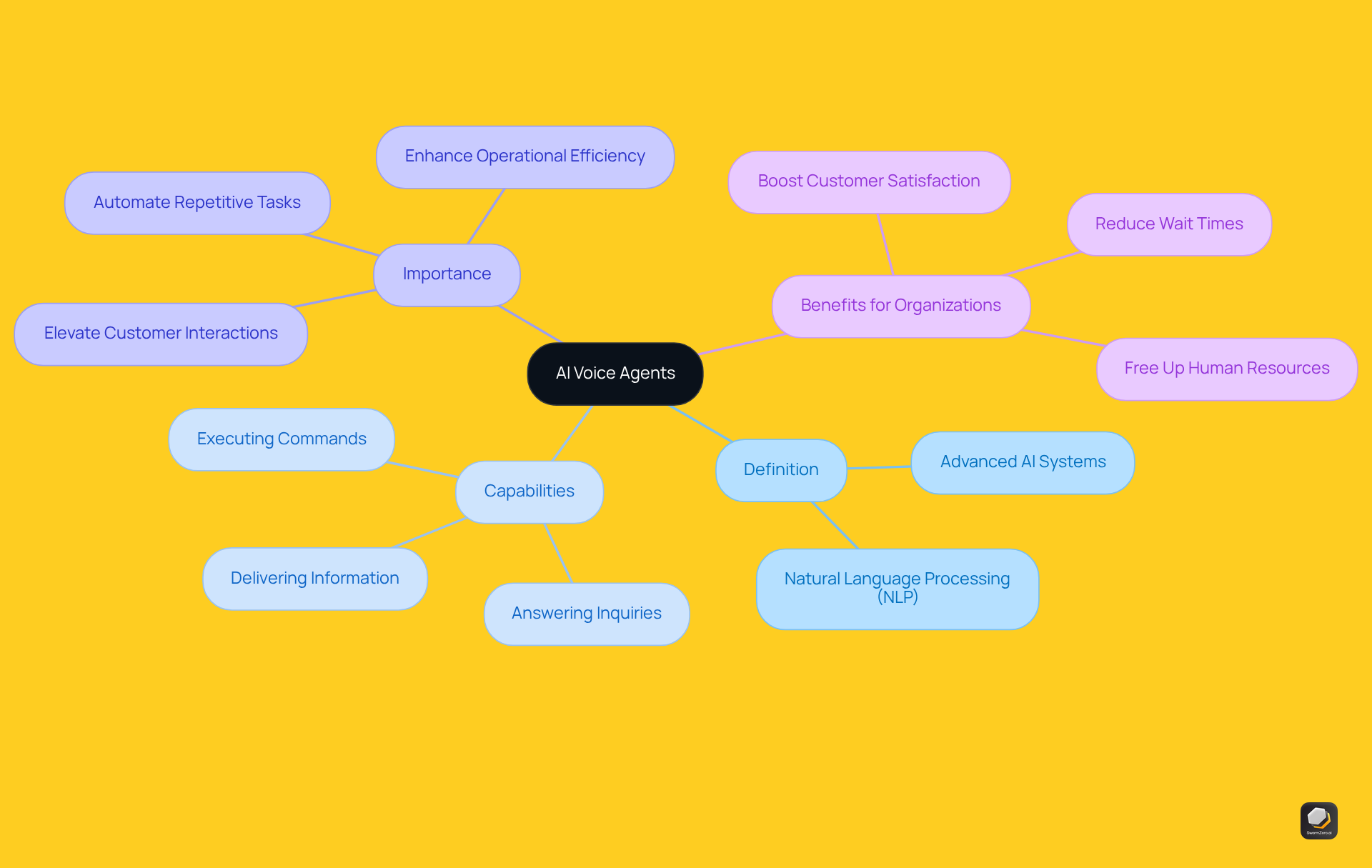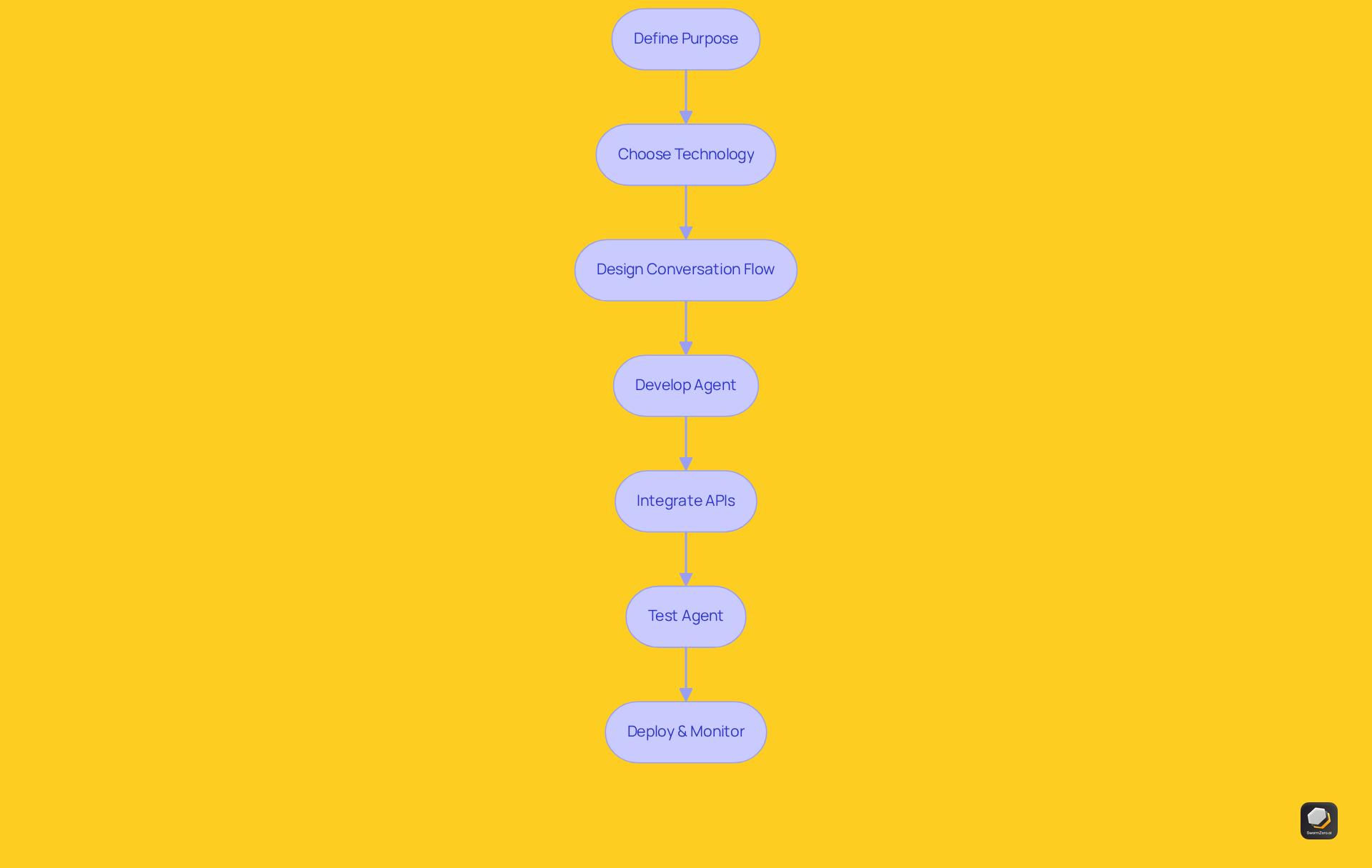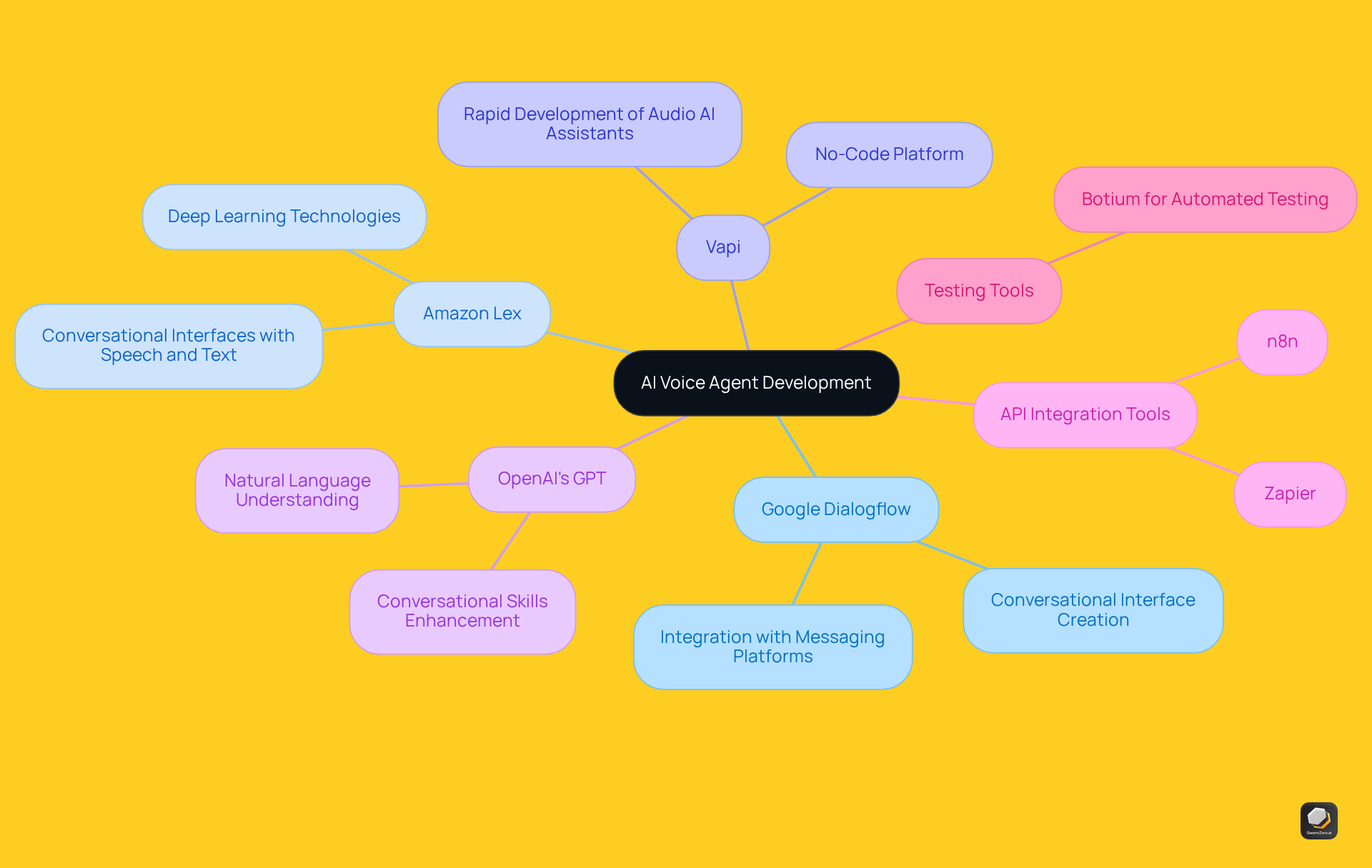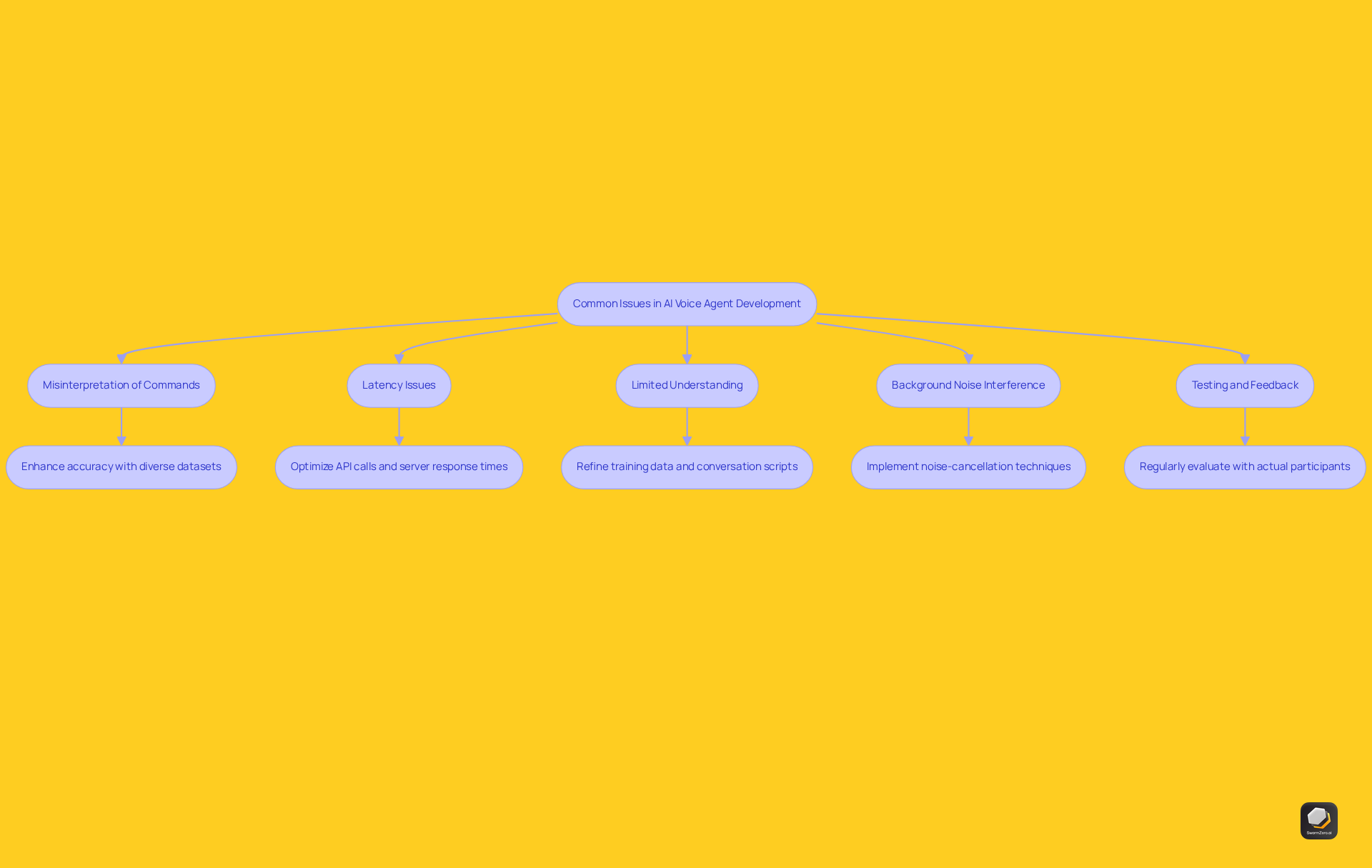How to Build an AI Voice Agent: A Step-by-Step Guide
Discover how to build an AI voice agent with our step-by-step guide for effective implementation.

Key Highlights:
- AI voice agents utilise artificial intelligence to understand and respond to human speech, performing tasks like answering inquiries and executing commands.
- They improve customer interactions, automate tasks, and enhance operational efficiency for businesses.
- Integrating AI voice assistants can reduce wait times, increase customer satisfaction, and allow human resources to focus on strategic initiatives.
- The development of an AI voice agent involves defining its purpose, choosing technology, designing conversation flows, and integrating APIs.
- Key technology platforms for development include Google Dialogflow, Amazon Lex, and Vapi, with a notable market trend of increasing budgets for voice AI.
- Common issues in development include command misinterpretation, latency, limited understanding, and background noise interference, each requiring specific strategies for resolution.
- Regular testing and feedback collection are essential for continuous improvement and ensuring the agent meets user expectations.
Introduction
Building an AI voice agent has emerged as a pivotal endeavour for businesses aiming to enhance customer interactions and streamline operations. These intelligent systems not only respond to inquiries but also automate tasks, resulting in improved efficiency and heightened customer satisfaction. However, the journey to creating an effective voice assistant is fraught with challenges.
From selecting the appropriate technology to ensuring seamless integration and user engagement, each step requires careful consideration. What are the essential steps and tools needed to navigate this complex landscape and develop a voice agent that genuinely meets user needs?
Understand AI Voice Agents: Definition and Importance
AI vocal assistants represent advanced systems that harness artificial intelligence to understand and respond to human speech. These systems are capable of executing a variety of tasks, including:
- Answering inquiries
- Delivering information
- Carrying out commands via natural language processing (NLP)
The importance of AI vocal assistants lies in their ability to:
- Elevate customer interactions
- Automate repetitive tasks
- Enhance operational efficiency
By integrating AI vocal assistants into business functions, organisations can:
- Reduce wait times
- Boost customer satisfaction
- Free up human resources for more strategic initiatives
Leveraging platforms like SwarmZero, which offers a comprehensive AI marketplace, businesses can develop, monetize, and automate solutions that incorporate AI-driven web search functionalities through the Tavily API. This integration further optimises the performance and efficiency of their conversational assistants.

Step-by-Step Process to Build Your AI Voice Agent
-
Define the purpose by identifying how to build an AI voice agent that can perform specific tasks, such as managing customer service inquiries, scheduling appointments, or providing product recommendations. This clarity will guide the development process and ensure the representative effectively meets user needs.
-
Choose the Right Technology: Select a platform that aligns with your requirements. Leading options in 2025 include Google Dialogflow, Amazon Lex, and Vapi, each offering unique features for speech assistant development. Notably, 84% of organisations intend to increase their voice AI budgets, reflecting a growing market for these technologies.
-
Design the Conversation Flow by planning how interactions will unfold, creating scripts that detail potential inquiries and corresponding replies from the assistant, as part of learning how to build an AI voice agent. Effective conversation design is essential, as it enhances user engagement and satisfaction.
-
Use your chosen platform to learn how to build an AI voice agent by developing the representative. This process typically involves setting up intents, entities, and responses based on your designed conversation flow. Continuous testing and iteration are crucial to improving the system's performance.
-
Integrate APIs: If your representative needs access to external data or services, integrate the necessary APIs. This functionality enables the representative to provide real-time information, enhancing its usefulness and the overall experience for users.
-
Test Your Agent: Conduct thorough testing to ensure the agent responds accurately to inputs. Almost 60% of callers will disconnect after just one minute on hold, underscoring the importance of timely and efficient responses. Adjustments should be made based on user feedback to improve accuracy and satisfaction.
-
Deploy and Monitor: After successful testing, deploy your AI voice assistant. Ongoing performance monitoring is vital, allowing for continuous enhancements based on user interactions. This proactive approach ensures that the representative remains efficient and relevant in a rapidly evolving environment.

Essential Tools and Resources for AI Voice Agent Development
To build an effective AI voice agent, consider the following tools and resources:
-
Google Dialogflow: This powerful platform enables the creation of conversational interfaces that seamlessly integrate with various messaging platforms.
-
Amazon Lex: A service designed for crafting conversational interfaces using both speech and text, it leverages the same deep learning technologies that power Alexa.
-
Vapi: A no-code platform that empowers developers to rapidly create and deploy audio AI assistants.
-
OpenAI's GPT: This tool enhances natural language understanding and generation, significantly improving your assistant's conversational skills.
-
API Integration Tools: Utilise tools such as Zapier or n8n to effectively link your speech assistant with other applications and services.
-
Testing Tools: Platforms like Botium are essential for automating the testing of your conversational interface's interactions.

Troubleshooting Common Issues in AI Voice Agent Development
When developing AI voice agents, several common issues may arise:
-
Misinterpretation of Commands: Enhance accuracy by training your agent with diverse datasets that encompass various accents and speech patterns. This method is essential; the average word error rate for advanced AI audio recognition systems decreased to 2.7% in 2023, indicating significant advancements in comprehending diverse speech. Such enhancement is crucial for establishing consumer trust, as 65% of individuals still have confidence in businesses that utilise AI technology.
-
Latency Issues: Optimise API calls and server response times to minimise delays in interactions. Minimising latency is critical, as users anticipate near-instantaneous replies from voice assistants.
-
Limited Understanding: Continuously refine your assistant's training data and conversation scripts. Regular updates can significantly improve comprehension, ensuring the agent can effectively handle a wider range of queries.
-
Background Noise Interference: Implement noise-cancellation techniques or encourage individuals to speak in quieter environments. This is particularly important, as 70% of consumers prefer using voice assistants in calm settings, highlighting the need for clarity in communication. Notably, speech recognition systems achieved 95% efficiency in noisy settings with beamforming, showcasing how technology can help mitigate this challenge.
-
Testing and Feedback: Regularly evaluate your system with actual participants and collect input to pinpoint areas for enhancement. Statistics indicate that businesses utilising AI-driven customer support experience a 20-30% decrease in operational expenses, underscoring the importance of iterative design informed by client feedback. Utilise this data to refine your understanding of how to build an AI voice agent's design and functionality, ensuring it meets user expectations effectively.

Conclusion
Building an AI voice agent presents a transformative opportunity for businesses seeking to enhance customer service and operational efficiency. By effectively harnessing artificial intelligence, organisations can develop systems that not only respond to inquiries but also automate various tasks, ultimately improving user experiences and satisfaction.
This article outlines crucial steps for developing an AI voice agent, including:
- Defining its purpose
- Selecting the right technology
- Designing conversation flows
- Integrating APIs
- Conducting thorough testing
The significance of ongoing monitoring and troubleshooting common issues, such as misinterpretation of commands and latency problems, is emphasised to ensure the agent remains effective and relevant.
As the landscape of AI voice technology evolves, embracing these strategies and tools is essential for any organisation aiming to leverage the advantages of AI voice agents. By investing in the development of these systems, businesses can reduce operational costs and significantly enhance customer interactions, paving the way for a more efficient and responsive future.
Frequently Asked Questions
What are AI voice agents?
AI voice agents are advanced systems that utilise artificial intelligence to understand and respond to human speech, capable of performing tasks such as answering inquiries, delivering information, and executing commands through natural language processing (NLP).
Why are AI voice agents important?
AI voice agents are important because they enhance customer interactions, automate repetitive tasks, and improve operational efficiency.
How do AI voice agents benefit businesses?
By integrating AI voice agents into their functions, businesses can reduce wait times, boost customer satisfaction, and free up human resources for more strategic initiatives.
What is SwarmZero?
SwarmZero is a platform that offers a comprehensive AI marketplace, allowing businesses to develop, monetize, and automate solutions that incorporate AI-driven web search functionalities through the Tavily API.
How does the Tavily API optimise conversational assistants?
The Tavily API enhances the performance and efficiency of conversational assistants by integrating AI-driven web search functionalities, enabling businesses to provide better services through their AI voice agents.
List of Sources
- Understand AI Voice Agents: Definition and Importance
- AI Voice Agents in 2025: Everything Businesses Need to Know | Retell AI (https://retellai.com/blog/ai-voice-agents-in-2025)
- The Economic Impact of AI Voice Agents on Customer Support (https://workhub.ai/economic-impact-of-ai-voice-agents-on-customer-support)
- AI Agents Statistics: Usage And Market Insights (https://litslink.com/blog/ai-agent-statistics)
- Customer Service: How AI Is Transforming Interactions (https://forbes.com/councils/forbesbusinesscouncil/2024/08/22/customer-service-how-ai-is-transforming-interactions)
- Aircall Unveils AI Voice Agent to Help Growing Businesses Handle Calls 24/7 (https://businesswire.com/news/home/20250409246023/en/Aircall-Unveils-AI-Voice-Agent-to-Help-Growing-Businesses-Handle-Calls-247)
- Step-by-Step Process to Build Your AI Voice Agent
- How To Build The Ultimate AI News Agent In 2025 (https://forbes.com/sites/aytekintank/2025/06/17/how-to-build-the-ultimate-ai-news-agent-in-2025)
- How To Build a Voice AI Agent in 2025 (Complete Guide) (https://raftlabs.com/blog/complete-guide-to-ai-voice-agents)
- What Is An AI Voice Agent and How To Build One? | Astera (https://astera.com/type/blog/ai-voice-agent)
- How to Build an AI Voice Agent: Step-by-Step Guide for 2025 (https://biz4group.com/blog/how-to-build-an-ai-voice-agent)
- Essential Tools and Resources for AI Voice Agent Development
- 30+ Voice AI Stats for 2025 (https://verloop.io/blog/voice-ai-statistics)
- AI Agent Statistics for 2025: Adoption, ROI, Performance & More (https://plivo.com/blog/ai-agents-top-statistics)
- 150+ AI Agent Statistics [July 2025] (https://masterofcode.com/blog/ai-agent-statistics)
- How to Build an AI Voice Agent: Step-by-Step Guide for 2025 (https://biz4group.com/blog/how-to-build-an-ai-voice-agent)
- OpenAI Launches New Tools for Building AI Agents | PYMNTS.com (https://pymnts.com/news/artificial-intelligence/2025/openai-launches-new-tools-building-ai-agents)
- Troubleshooting Common Issues in AI Voice Agent Development
- 30+ Voice AI Stats for 2025 (https://verloop.io/blog/voice-ai-statistics)
- 22 Top AI Statistics And Trends (https://forbes.com/advisor/business/ai-statistics)
- Newest AI Voice Recognition Statistics and Developments (https://seosandwitch.com/ai-voice-recognition-stats)
- 150+ AI Agent Statistics [July 2025] (https://masterofcode.com/blog/ai-agent-statistics)
- 80+ AI Agent Usage Stats for 2025 | Zebracat (https://zebracat.ai/post/ai-agent-usage-statistics)




